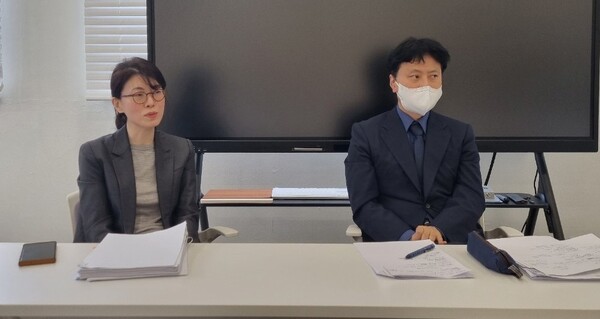The Ministry of Health and Welfare, which launches a pilot project for telemedicine Thursday with no set time frame, aims to institutionalize it within the 21st National Assembly’s term that has about a year left.

Regarding why the pilot project fee was set at 130 percent of the existing fee, ministry officials said many things need to be considered in conducting non-face-to-face treatment compared to face-to-face care, such as confirming patients.
On Tuesday, two ministry officials – Director Cha Jeon-kyoung of the Health and Medical Policy Division and Director Ha Tae-gil of the Pharmaceutical Affairs Division – met with journalists to explain the pilot project.
Director Cha said the ministry prioritized safety issue in pushing the pilot project.
“The number of patients who used non-face-to-face medical treatment during the Covid-19 period reached 14 million, so it was inevitable for use to fill the gap until the revision of the Medical Service Act (to institutionalize non-face-to-face medical treatment),” she said explaining the background of the pilot project. “The most worrying issue while pushing the pilot project was safety.”
Noting that the pandemic forced the government to allow non-contact treatment temporarily, Cha said that is not the case now.
"Now that people can visit hospitals and pharmacies freely (without risking the spread of infection), we had to take an approach different from temporary telemedicine, thinking about safety,” she said.
Nevertheless, the government had no other option but to push for the pilot project before revising related laws because it could not avoid the issue of public access to healthcare services and their convenience as well as safety, Cha added.
"We could not ignore the accessibility and convenience of non-face-to-face medical treatment (which had already been introduced for a limited time)," Cha said. "We tried to look at both sides -- safety on the one hand and accessibility and convenience on the other -- and should continue to balance them in the future.”
Cha went on to say, “After launching the pilot program, the government will continue to listen to feedback by forming an advisory group. In addition, we will meet with everyone we can, including medical organizations, patient organizations, and consumer organizations, to carry out the virtual care program in balanced ways.”
She also explained the difference between what was agreed on between the government and the ruling party on May 17 and the final plan reported by the Health Insurance Policy Deliberation Committee (HIPDC).
For instance, the government-ruling party agreement allowed telemedicine for first-time patients aged 65 and older. Still, the HIPDC plan narrowed targets to only older adults classified as long-term care recipients.
Also, while the government-ruling party plans allowed telemedicine for first-time patients under 18 receiving care on holidays and at night, the HIPDC plan permitted only non-face-to-face medical consultation but not prescribing drugs for them.
Concerning targets eligible for receiving drugs at home, the government-ruling party plan allowed it to all patients with infectious diseases. Still, the HIPDC plan limited them to patients with first- or second-class infectious diseases.
“(The government-governing party plan) was a draft. We didn’t want to make it too clear because there’s no point in soliciting comments,” Cha said. “In contrast, the HIPDC plan clarified targets for second-time patients and emphasized safety. We reflected input from the pediatric community and other opinions from academic societies in this process.”
Cha also explained the reason the drug delivery was all but excluded from the pilot program.
"During the pandemic, there was an important goal of preventing the spread of infectious diseases through non-face-to-face medical care, even at the expense of omitting drug-administering guidance," she said. “In normal situations, however, we had to consider safety more in drafting the pilot program.”
Commenting on why the telemedicine fee was set at 130 percent of the face-to-face treatment fee, which was not included in the government-ruling party agreement, Cha said, “We considered it is a pilot program. We need to verify eligibility, and there are procedural complexities (compared to in-person care).”
She also explained why, unlike other pilot projects, there is no set timeframe for the experimental virtual care program.
"The Ministry of Health and Welfare aims to institutionalize non-face-to-face care through legal revision, not through pilot projects. Therefore, we will try to streamline the pilot project results so that it can be institutionalized,” Cha said. “We will make such efforts in parallel with the pilot project so that we can institutionalize it before the end of the 21st National Assembly.”
She acknowledged the pilot project would not satisfy everybody.
“However, as there are conflicts within non-face-to-face treatment between safety and accessibility and convenience, it is important to harmonize these to promote and protect public health,” Cha said. “Even after the pilot project is over, we will continue to listen to experts and field opinions to find the best way.”
Related articles
- Korea's telemedicine pilot project backfires, putting everyone at stake
- Telemedicine industry calls for overhauling government’s pilot program
- Dermatology records highest first-time treatment rate of 26% in temporary telemedicine
- Share of first-time treatment remains only 9% of telemedicine
- ‘More pilot projects needed to promote value of telemedicine in Korea’
- Hospitals to check patients’ eligibility for remote care from next month

